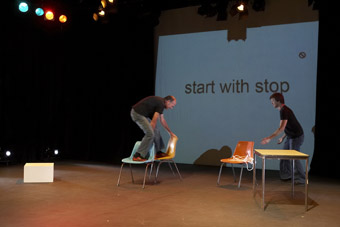Everyone an artist everyday
Jonathan Marshall takes a turn at Putting on an Act

Clyde McGill, Mark Parfitt, Instruction Action Space
photo Jon Green
Clyde McGill, Mark Parfitt, Instruction Action Space
PICA’s annual Putting on an Act program encourages artists to stage short works of any genre or style, eliciting some of the best (and worst) “one-shot” performances of the year. Fresh from teaching the history of Fluxus and performance art, I particularly warmed to the more unstructured pieces.
Throughout the 1960s, John Cage, Yoko Ono and others composed works by penning a series of instructions (“Enter space containing a radio and 3 musical instruments. Roll a dice to determine which station to tune the radio to and which instrument to play in which order” etc). The point was to defer the artists’ status as authors of something aesthetic and so make everyone a potential artist and everything a potential aesthetic object—the aesthetics of the everyday. Cage himself though was often lax in detailing the power play involved in handing out such obscure directions to his acolytes. Instruction Art Space from Clyde McGill and Mark Parfitt constituted in this sense a re-interpretation of the idea whereby instructions became potentially oppressive, exhausting and often nonsensical, endlessly thrown out to us by authorities as varied as train station announcers, advertisers, bosses and cops. One-word instructions were read out over the sound system (“Rotate!” “Think!” “Run!” “Tangle!”), while another set was projected on the back wall with additional confusion provided by the 2 performers shouting their own instructions at each other. The pair then struggled to respond with what they had to hand: a tube, some rope, 2 chairs and 2 small tables. They charged around, producing a predictable but thoroughly enjoyable, unstable chaos of flying furniture, shouting, clambering about, bodily contact, arm-locked whirling and other flailing attempts to keep up with their orders. As one exclaimed while the lights dimmed, “I’m buggered!” or as that great authority figure Malcolm Fraser quipped, “Life wasn’t meant to be easy.”
A more considered approach was offered by Greg Burley’s Second Law of Homecoming, a superb monologue about his slip into insensitive monomania during a period of share housing. Obsessed with the first few bars of one of Neil Young’s songs, he related how he had played this 10-second refrain hundreds of times a day to allay a gap in his mind (thoughts had ceased to come to him spontaneously, a phenomena which did not have the calming effect some might attribute to it) and to cope with his intimidatingly stoic, unresponsive housemate. At the finish of this encounter, Burley explained how he had finally understood and empathised with his housemate at the very point that the latter had calmly, sadly and without malice asked him to move out. Although the narrative itself was delightful, its true charm came from Burley’s deliberately un-aesthetic delivery. Words and explanations were lingered over, giving them a poetic beauty and ambiguity, while Burley’s unhurried, simple vocal delivery and slightly halting presentation imparted a sense of the everyday. Burley himself remained beguilingly opaque.
My third pick of the season was the more overtly theatrical monologue Running, from writer-performer Kym Cahill and director-animator Tim Watts. Cahill re-enacted her childhood terror of being abandoned in broad daylight, far from civilisation, in an old graveyard as her school bus with her best friend sped away. As though laying out a lifeline, Cahill began by coiling a rope from the seating (the bus) to the rear of the stage. She then walked the curves of the rope while relating to us her dubiously ‘educational’ task of identifying the dates on the graves she passed. Then, as the bus threatened to leave, Cahill’s voice rose, her chest heaved and quaked. Behind her a simple animation flickered on the back wall: empty desert sands and an increasingly tilted, far horizon. A rolling pattern of horizontal lines in the brown earth established the fervid dynamism of her dash for the bus. The disorientating affect of this exaggeration of distance accompanied by Cahill’s escalating gasps was effectively emphasised by the inversion of foreground (the projected sands on the wall) and background (Cahill moving towards the audience as though through molasses), before her character fainted.
For my own part, after also enduring Tomàs Ford’s Unpleasant Tone (literally that: a single tone played and tweaked to an empty stage) and a work by Abe Sada (massive rumbling bass feedback played underneath the seating), as well as the more than 28 other pieces over a 4 day program, I felt like fainting myself!
Putting On An Act, Instruction Action Space, concept/performance Clyde McGill, Mark Parfitt; Greg Burley’s Second Law of Home Living, concept/performance Greg Burley; Running, by Weeping Spoon Productions, writer-performer Kym Cahill, director-animator Tim Watts; Unpleasant Tone, concept/performance Tomàs Ford; Abe Sada (Chris Cobilis, Katerina Katherine Papas, Bassta! Pex, Cat Hope), concept Cat Hope, Andrew Ewing; PICA, June 13-17
RealTime issue #74 Aug-Sept 2006 pg. 48






